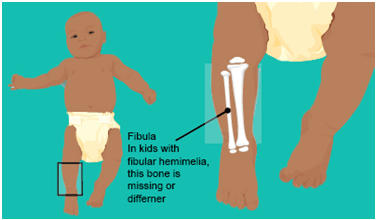Fibular Hemimelia
Fibular Hemimelia is a rare birth defect of uneven length in the lower limbs. It refers to a congenital disability in which the fibular bone or a part of it is missing. Also, there could be limb length discrepancies and deformities in either the knees and/or the foot. It can affect both limbs, which is extremely rare.The child will be unable to stand and walk properly upon growth, and hence early treatment to treat this condition is advisable.

If your child has been diagnosed with fibular Hemimelia, then regular observation and early treatment are essential. It is necessary to consult a pediatric orthopedic surgeon for assessment and deciding on the comprehensive treatment for your child.
Dr. Ratnav Ratan is a dynamic pediatric orthopedic doctor in Gurgaon to treat babies, growing children, and sportspeople suffering from joint and bone disorders, trauma, and related medical conditions. He has more than thirteen years of experience in treating patients with pediatric orthopedic complaints and disorders.
His areas of expertise include Cerebral palsy, Syndactyly, Developmental Dysplasia of hips,Clubfoot, Genetic or developmental skeletal disorders, Flatfoot, Pediatric trauma, Perthes Disease, and many other orthopedic conditions.
Symptoms of Fibular hemimelia (visible at birth)
- Leg length discrepancy means one leg is shorter than the other as some or all of the bone is missing in one leg.
- Not properly developed ankle joint as the shinbone is missing or short. The ankle and the foot do not look normal.
- Inward bending of the child’s knee and lower leg
- The child’s foot may have less than five toes.
- The lower leg of the child may be bowing outwards.
Other symptoms detected through a medical examination are
- Shallow hip joint
- Weak or missing ligaments of the knee
Detection and diagnosis of Fibular hemimelia
It is possible to diagnose this condition through an ultrasound scan that displays the extent of baby’s growth in the womb during the pre-natal stage.
If fibular hemimelia is detected after birth, then x-rays and MRIs will help in showing the extent of the deformity.
Treatment of Fibular Hemimelia
The treatment of fibular hemimelia depends upon to what extent the child is affected by it. The doctor will recommend an extensive treatment if there is a considerable difference in the limb length and joint health is unstable. On the other hand, minimal treatment is suggested to a child with a negligible limb length difference.
Children with this condition will experience difficulty in walking or standing. Also, the growth of their legs will be slow, and the leg is unlikely to have a normal length.
The treatment of fibular hemimelia depends upon these evaluation factors
- The difference in the length of the deformed and the normal leg
- Of what size is the missing bone
- Whether the child has deformed ankle and foot conditions too
- The mobility factor of the child in the future on account of fibular hemimelia
The child will have to wear a shoe insert or special shoe if they are detected with a mild condition of fibular hemimelia is a non-invasive treatment.
However, surgery is the preferred treatment to resolve most conditions of fibular hemimelia.
Various Surgery options to resolve Fibular Hemimelia
- Epiphysiodesis – Ideal for children who have minor differences in leg length. This surgery is ideal for kids during their growing phase. The orthopedic surgeon prevents the longer leg from growing further, and thus the shorter leg matches up with, the longer leg upon growing.
- Leg-Lengthening Surgery: This surgery can add nearly 20 cms or 8 inches of length to the shorter leg. Through this surgery, a lengthening device is placed either internally or externally on the shorter leg. Multiple surgeries are required for the legs to have matching lengths.Other surgeries involve repairing muscles, joints, and bones that help resolve other conditions associated with fibular Hemimelia, after which the children can stand and walk independently.
Treatment for Severe Fibular Hemimelia
Severe Fibular Hemimelia implies there are no chances of resolving this condition, and the child will have experienced difficulty in movement throughout his or her life. For such cases, doctors recommend wearing a prosthesis.
Amputation surgery is performed so that the prosthesis can be worn comfortably by the child. Post amputation and with a customized prosthesis, the child can become extremely active and play sports. The child will regain confidence and look forward to having a near-normal life. Prosthetic legs need to be checked annually for making suitable adjustments as per the growth of the child.




